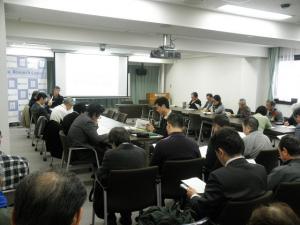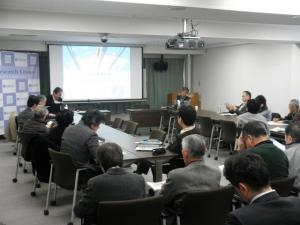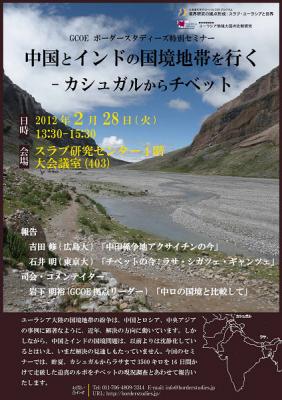
Report on the Special Seminar °∆From Kashgar to Tibet: Along the Sino-Indian Border Region°«
2012/02/28
On 2 February, the Global COE Border Studies Special Seminar was held at the Slavic Research Center, Hokkaido University. The Seminar was publicized in the Hokkaido Times, and despite it being a weekday, the room was packed with over 60 people in attendance.
At the Seminar, YOSHIDA Osamu (Professor at Hiroshima University) and ISHII Akira (Emeritus Professor at the University of Tokyo) gave reports on the current state of the Sino-Indian border region on the basis of their research trip in the summer of 2011.
 In his presentation, °∆Aksai Chin between China and India°«, Professor YOSHIDA touched on the history of Sino-Indian competition before emphasizing the Chinese state°«s current policies of accelerated infrastructural development in its border regions and the continuing restrictions on the entry of foreigners into these areas.
In his presentation, °∆Aksai Chin between China and India°«, Professor YOSHIDA touched on the history of Sino-Indian competition before emphasizing the Chinese state°«s current policies of accelerated infrastructural development in its border regions and the continuing restrictions on the entry of foreigners into these areas.  Professor ISHII gave a talk called °∆Contemporary Tibet: Lhasa, Shigatse and Gyangzê°« in which he highlighted how the state, under the rubric of °∆public order°«, is engaging simultaneously in increased surveillance and accelerated economic development of the region, and explained that this was resulting in the problem of restrictions on movement for everyone, including foreigners.
Professor ISHII gave a talk called °∆Contemporary Tibet: Lhasa, Shigatse and Gyangzê°« in which he highlighted how the state, under the rubric of °∆public order°«, is engaging simultaneously in increased surveillance and accelerated economic development of the region, and explained that this was resulting in the problem of restrictions on movement for everyone, including foreigners.
Following these two presentations on the situation in China°«s eastern border regions, Global COE head Professor IWASHITA Akihiro provided a comparison with China°«s borders in the west. He spoke of the trend mirroring that in other parts of the world, with borders here being more clearly defined, the construction of various monuments being undertaken on the Chinese side of the border, and the memory of past strife being maintained into the present.
He spoke of the trend mirroring that in other parts of the world, with borders here being more clearly defined, the construction of various monuments being undertaken on the Chinese side of the border, and the memory of past strife being maintained into the present.
From the floor came historical questions on relations between the Mongols and Tibetans and Chinese motivation during the Sino-Indian wars.
At the Seminar, YOSHIDA Osamu (Professor at Hiroshima University) and ISHII Akira (Emeritus Professor at the University of Tokyo) gave reports on the current state of the Sino-Indian border region on the basis of their research trip in the summer of 2011.
 In his presentation, °∆Aksai Chin between China and India°«, Professor YOSHIDA touched on the history of Sino-Indian competition before emphasizing the Chinese state°«s current policies of accelerated infrastructural development in its border regions and the continuing restrictions on the entry of foreigners into these areas.
In his presentation, °∆Aksai Chin between China and India°«, Professor YOSHIDA touched on the history of Sino-Indian competition before emphasizing the Chinese state°«s current policies of accelerated infrastructural development in its border regions and the continuing restrictions on the entry of foreigners into these areas.  Professor ISHII gave a talk called °∆Contemporary Tibet: Lhasa, Shigatse and Gyangzê°« in which he highlighted how the state, under the rubric of °∆public order°«, is engaging simultaneously in increased surveillance and accelerated economic development of the region, and explained that this was resulting in the problem of restrictions on movement for everyone, including foreigners.
Professor ISHII gave a talk called °∆Contemporary Tibet: Lhasa, Shigatse and Gyangzê°« in which he highlighted how the state, under the rubric of °∆public order°«, is engaging simultaneously in increased surveillance and accelerated economic development of the region, and explained that this was resulting in the problem of restrictions on movement for everyone, including foreigners.Following these two presentations on the situation in China°«s eastern border regions, Global COE head Professor IWASHITA Akihiro provided a comparison with China°«s borders in the west.
 He spoke of the trend mirroring that in other parts of the world, with borders here being more clearly defined, the construction of various monuments being undertaken on the Chinese side of the border, and the memory of past strife being maintained into the present.
He spoke of the trend mirroring that in other parts of the world, with borders here being more clearly defined, the construction of various monuments being undertaken on the Chinese side of the border, and the memory of past strife being maintained into the present. From the floor came historical questions on relations between the Mongols and Tibetans and Chinese motivation during the Sino-Indian wars.






